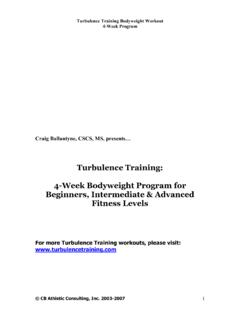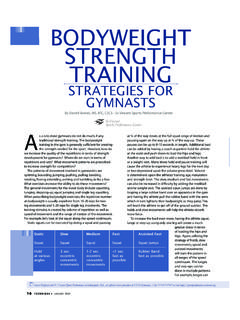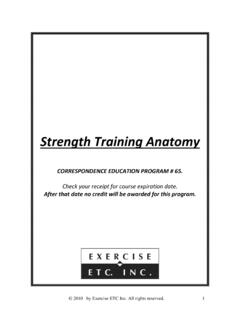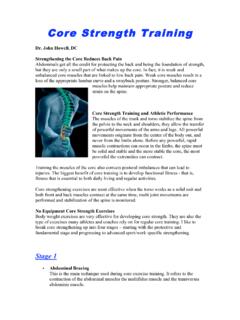Transcription of FOREWORD - CFMWS
1 1 FOREWORDP hysical fitness is inherent to mission readiness both domestically and abroad. CF personnel may not always have access to a fitness facility or equipment while deployed or on travel-related duty. bodyweight exercises do not require free weights or resistance training equipment. This training manual provides an easy-to-follow, integrated training regimen that will enable CF personnel to maintain a fitness training routine in less than ideal conditions. The exercises included can be performed anywhere, at any time, with limited physical space and with no equipment. For additional fitness programming support and resources, visit us at AllardDirector of Fitness2 TABLE OF CONTENTSINTRODUCTION 4 bodyweight training SYSTEM 5 GETTING STARTED 6 GUIDELINES 10 SCHEDULE 13 RECOVERY 17 bodyweight training WORKOUT (BT)
2 17 TERMINOLOGY TECHNIQUE 21 EXERCISE VARIATIONS 24 WARM UPS 1-3 27 BODY training 1-12 33 BODY training + 45 AEROBIC S 49 CORE STABILITY 1-3 53 COOL DOWN 1-2 57 ABOUT THE AUTHORS 593 bodyweight training SYSTEMACKNOWLEDGEMENTSThe Director General Personnel and Family Support Services have developed a bodyweight Physical Fitness training Program for CF AuthorityBen Ouellette, CEP, CSCSA uthorsMichelle Cormier, CEPG eoffrey Drover, CEP, CSCSMary-Beth McGinn, CEP, CPT-CCTodd Stride, CEP, CSCST echnical ContributorsGuylaine Charbonneau, , Charron, CEPD uane Farrell, CEP, CSCSA aron Grainge, CEP, CSCSD anielle Henry MHK (c), CPTL ucie Laferri re, PT MHAT echnical WriterPaul DaleDesign/LayoutMelissa GauthierImageryLyndon GoveasCombat Camera4 INTRODUCTIONM embers of the Canadian Forces must be physically fit to meet the demands of operations.
3 A combination of health- and performance- related fitness components contribute to their ability to function in complex and challenging environments. These components include cardiovascular endurance, muscular strength and endurance, mobility, flexibility, agility, balance, coordination, speed and power. Members must also demonstrate a high level of functional fitness the ability to use these trained components to perform military-related tasks efficiently and effectively. When members do not have access to a fitness facility or equipment, they can use bodyweight exercises to maintain cardiovascular and muscular endurance. bodyweight exercises, such as the push-up, squat and lunge, do not require free weights or resistance training equipment because the weight of the body provides resistance for each specific movement.
4 The bodyweight training System (BTS) is a physical fitness training program that can be performed anytime, anywhere, with limited physical space, and no equipment. 5 bodyweight training SYSTEMThe BTS is a bodyweight exercise program that combines functional training , core exercises, and aerobic workouts to enhance endur-ance, mobility, agility, and power. Each training session is made up of three basic building blocks: warm-up, workout, and cool-down. Warm-Up (10-15 minutes)The warm-up consists of light aerobic activity, stretching, mobility, and specific movement preparation. Exercises progress gradually in both complexity and intensity. The warm-up will: prepare your body for the demands of the workout provide an opportunity for mental preparation introduce skills through rehearsal enhance performanceWorkouts (10-30 minutes)The BTS contains three types of workouts that are included in the weekly exercise sessions: bodyweight training (BT) workouts consist of functional multi-joint movements, such as the squat and lunge, which use bodyweight to develop muscular strength and endurance.
5 Aerobic (AR) workouts include continuous full-body movements of varying intensity with the objective of enhancing cardio-respiratory func-tion. Running on the spot, jumping jacks and quick feet are examples of exercises included in AR workouts. Core Stability (CS) workouts consist of ex-ercises such as the bird dog and planks, which develop the ability to stabilize the body during movement by targeting the muscles of the abdominal wall, pelvis, and lower back. 6 Cool-Down (5-10 minutes) The cool-down is performed after the workout and consists of low intensity aerobic and flexibility exercises. The cool-down will: gradually transition your body to a normal resting state restore your heart rate and blood pressure to pre-exercise levels optimize your recovery process and improve flexibilityGETTING STARTEDThe BTS is designed for CF personnel who have already demon-strated the ability to meet the CF Minimum Physical Fitness Stan-dards (MPFS).
6 Personnel who are unable to meet the current MPFS should consult Personnel Support Program (PSP) fitness staff for an appropriate exercise prescription. Check Your HealthSome individuals may require medical clearance before they start an exercise program. The two health appraisal questions below are used to identify personnel for whom physical activity may be inap-propriate at this time. If you answer YES to one or both questions, you should consult your Medical Care Provider prior to beginning this Appraisal QuestionsYesNoTo the best of your knowledge do you have a medical condition or Medical Employment Limitation that restricts you from participating in a fitness evaluation or a progressive training program?
7 Is there any other reason you would like to talk to a physician prior to your fitness evaluation or training program?7 The fitness check is comprised of three fitness tests:Lower Body Muscular Endurance (Squat Test)Note: Stop the test if you experience any pain or discomfort. a. From a standing position, descend until the top part of the thigh is parallel to the ground. b. Stop the descent if heels raise, knees turn inwards, or neutral spine is lost. c. Lower for a count of 2 seconds, pause for one second at the bottom, and return to the start position for a count of 2. d. Record the number of squats completed without stopping. e. Only squats completed correctly should be counted - reference the Squat Technique section for additional CheckThe BTS has three levels to accommodate varying degrees of physical fitness.
8 The Fitness Check is used to identify your appropri-ate starting level and will serve as a benchmark to verify training improvements. To determine your appropriate starting level: a. complete each of the fitness checks b. record your respective time/repetitions on the progress chart (Table 1) c. identify the corresponding level for each of the three exercises using the Fitness Check Reference (Table 2)You are ready to change programs when you can perform all of the fitness tests for the prescribed time/repetitions of the next level. Each of the levels should be seen as the foundation before you progress to the next stage. Complete warm-up 1 (WU 1) before attempting the fitness check and finish with cool-down 1 (CD 1).
9 8 Upper Body Muscular Endurance (Push-Up Test)Note: Stop the test if you experience any pain or discomfort. a. Assume a push-up position with the hands flat on the floor shoulder-width apart, point your fingers forward, and maintain a straight line from your shoulders to your heels. b. Lower yourself until the backs of the upper arms are parallel to the floor and rise until the arms are straight. c. Record the number of push-ups completed without Endurance (Plank Test)Note: Stop the test if you experience any pain or discomfort. a. Support yourself with the forearms and toes. b. Hold this position and maintain a straight line from your shoulders to your heels.
10 C. Keep the feet together and the shoulders positioned directly above the elbows. d. Maintain the position until you can no longer keep a straight body position. e. Time and record your performance in seconds. The initial fitness check must be performed at least 48 hours prior to commencing the first week of the ComponentFitness TestLevel ILevel IILevel III*BeginnerIntermediateAdvancedLower Body Muscular EnduranceSquat< 30 reps30-75 reps> 75 repsUpper Body Muscular EndurancePush-Ups7-19 reps 20-30 reps > 30 reps Core EndurancePlank< 60 sec60-120 sec> 120 sec* Prior to attempting level III, we recommend that you achieve CF MPFS incentive levels. sec - time in seconds; > - greater than; < - less thanTable 2: Fitness Check ReferenceFitness TestInitialWeek 5 Week 10 Week 15 ScoreLevelScoreLevelScoreLevelScoreLevel SquatPush-UpsPlankTable 1: Fitness Check Progress Chart10 GUIDELINES Adhere to the following training guidelines to ensure that you com-plete the BTS safely and effectively.









